 The founder of the SAS was a Scottish Laird named David
Stirling. Prior to World War II, Stirling was engaged in training to climb Everest. He was
always adventurous, and eager to take on new challenges. He definitely stood out in a
crowd; at 6 foot, 5 inches frame he was not one to be ignored. The founder of the SAS was a Scottish Laird named David
Stirling. Prior to World War II, Stirling was engaged in training to climb Everest. He was
always adventurous, and eager to take on new challenges. He definitely stood out in a
crowd; at 6 foot, 5 inches frame he was not one to be ignored.
When the war started, Stirling joined the Scots Guards as a subaltern, but soon
volunteered for 8 Commando, named after it's commander Captain Robert Laycock as Layforce.
At this time in history all Special Forces elements were viewed by the military
establishment as more cost then they were worth. "Private Armies" as they were
disdainfully known were given little support in quality men and materiel, and were under
trained and over-criticized. An Old-Guard mentality was pervasive, and set-piece battles
were seen as the only way to achieve success. Young David Stirling got his first taste
of this in Layforce which was dismantled in all but name prior to arriving in North
Africa. Special Forces as used in North Africa seemed doomed by this unfortunate
circumstance.
Fortunately for the British army, David Stirling saw the possibilities for Special
Operations behind enemy lines. He reckoned that a group of highly-trained, highly
motivated soldiers could wreak havoc on enemy supply lines, bases and moral. He joined
forces with Australian Jock Lewes , an officer with the Welsh Guards, and this meeting
would prove to be the nucleus of the Special Air Service Regiment.
Lewes, an amazing adapter and improviser had scrounged a supply of fifty parachutes, which
at first seemed to be the best mode of delivery for troops to get behind the lines. He and
David started to jump immediately, and the result was at one disastrous and fortuitous.
Disaster struck when David jumped from the old Valentia aircraft, which was most unsuited
for the job, his parachute snagged on the tail of the aircraft. David was injured in the
fall, and he ended up spending 2 months in the hospital. While uncomfortable, he was now
able to devote his time to planning his new unit.
Upon his release from the hospital, Subaltern (2nd Lt.) Stirling headed straight for the
High-Command Head-Quarters to see the Commander-in-Chief General Auchinlek. Now, the
British military establishment has a strict protocol, and the chain of command had to be
obeyed to the letter. David knew that if he tried to get things done in an appropriate
fashion, it would never come to bear fruit. So David slipped past the guard, on crutches,
and hobbled into the building, hastily seeking refuge in an office. In this office was
Deputy Commander Middle East General Ritchie. Ritchie was instrumental in the formation of
the new unit. He read David's pencil written notes, and promptly presented the plans to
Auchinlek. Both Generals saw the opportunity to use the new unit immediately, as an
offensive was planned for the near future. The new unit was to consist of sixty-six men
from Layforce, including seven officers and many NCO's. This independent command was to be
called L Detachment, Special Air Service Brigade. This was done to make the German's think
it was larger than it actually was. Stirling's dream had become reality.
Thus began an unparalleled adventure in North Africa. Rommels Afrika Korps had arrived,
Britain's forces where being pushed back to Egypt by the Desert Fox, and supplies to the
Allies were running
short as Malta lay under siege. The first mission for the SAS (November 17th 1942) was to
jump behind enemy lines and gather intelligence as well as harassing and tying up German
forces while the
British mounted the offensive. It was a disaster. Because moral was high and the troops
well trained,
Stirling decided to jump despite terrible conditions. Many men never made it back, of the
sixty-six who went only twenty-two returned. While disastrous, Stirling and his officers
Lewes and Paddy Mayne learned much from the experience.
One of the most import innovations came from Jock Lewes, who was challenged to devise a
bomb small enough to be carried which would both explode and ignite when detonated to put
a plane out of action. The Lewes Bomb was created, out of oil and thermite. It would
explode on top of a wing and ignite the fuel within. It weighed one pound, and one man
could carry enough to decimate a squadron of planes.
The focus now changed from aircraft insertion to overland. The Long Range Desert Group, a
motorized reconnaissance unit would pick up the SAS raiders, circle south and west then
north to enemy territory, drop off their cargo and rendezvous at a specified point at a
predetermined time. The SAS would walk to their destination, usually an airfield carrying
minimal weapons and supplies. They moved mostly at night and laid up during the day to
avoid German and Italian Air and foot patrols.
The most successful of all the raiders was Paddy Mayne, an Irish rugby player who's fierce
determination and courage accounted for dozens of planes blown on the tarmac. At one
point, out of
Lewes bombs, he ripped out an aircraft control panel with his bare hands. He is a legend
in the Regiment today, embodying the rugged individualism sought when recruiting Special
Forces personnel.
As the SAS successes mounted, and dozens of aircraft were destroyed on the ground, the
Germans high command took notice. Their activities caused Hitler to issue the infamous
Kommandobefehl , To
his credit Field Marshal Irwin Rommel was the only German General that disregarded this
order and
treated Special Ops prisoners of war in the correct manner . acc to
Geneva Convention .
Accordingly, the German Army stepped up security and patrols in order to intercept the
Raiders. This caused a change in tactics - along with the acquisition of several Jeeps.
The SAS could now mount their own mobile operations. Jeeps were equipped with twin Vickers
K machine guns, and became a formidable weapon, perfect for the long, rugged journeys they
encountered. The jeeps formed the nucleus for mounted raids on enemy airfields. A Squadron
of jeeps would enter onto the tarmac, fan out and throw a sustained series of fire ,
consisting of tracers at the aircraft, causing them to be torn to shreds and ignite. This
caused so much confusion that casualties for the SAS tended to be light, and they could
slip away back into the desert. These operations lost quite a few jeeps due to enemy fire
or break-downs. The cost was insignificant compared to the amount of damage inflicted.
The SAS Brigade in Europe
Eventually, disaster struck when David Stirling was captured and imprisoned at Colditz POW
camp, where he was to spend the rest of the War. His brother Bill ended up commanding 2
SAS, while Paddy Mayne took over David's position as commander of 1 SAS. The War in North
Africa ended, and Allied attention turned to Europe. SAS units became useful for
establishing bases in France, far behind enemy lines. They were dropped in the standard
squads of 4 men with limited supplies. Often they would contact groups of Maquisards, and
arrange for drops of supplies, weapons and communications equipment. The SAS teams would
implement training and carry out daring raids on German supply depots, rail-lines and
strategic positions. Reconnaissance was the most important function as the Allies prepared
for Operation Overlord, the D-Day Invasion. The SAS succeeded in tying up hundreds
of German troops who otherwise would have been used against the Allies at Normandy
These actions were perilous for the men involved. At one point, twenty four
men plus a US air force pilot were captured and evidence shows they were tortured and
executed in dreadful fashion. ( see operation bulbasket )
Hunter Teams
An SAS team remained in Europe at the end of the War, They investigated the deaths of
their comrades who had been murdered after being captured in action They hunted down
specific targets , SS men and Gestapo , Wermacht , and civilian traitors who tried
to hide or slip away in the chaos.
Memorial Statue
Patrick W Anderson wrote in
saying... Yesterday in glorious weather we visited DOUNE and having heard
about the DAVID STIRLING Memorial statue from a friend my wife and I drove
along the DOUNE to BRIDGE OF ALLAN road and just outside DOUNE in
Stirlingshire on the B 824 road there is a wonderful statue of DAVID
STIRLING dressed in Army Uniform and his Officers coat and he's holding a
pair of Binoculars in his hand. He is looking north and I would expect that
would mean that he was looking north to his ancestral lands FORFEITED as his
ancestors had their lands seized by the Crown after the 1745 rebellion being
Jacobites.
Pictures of the Statue
Ranald McIntyre kindly took me for a run up to see the statue on 29th
July 2003 and here are a few photos we took. Clicking on the pictures will
bring up a larger image.
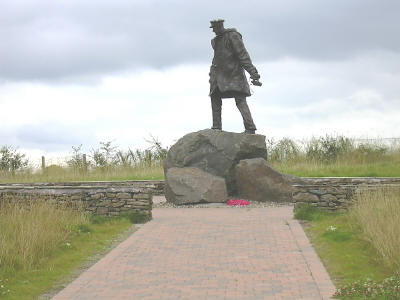
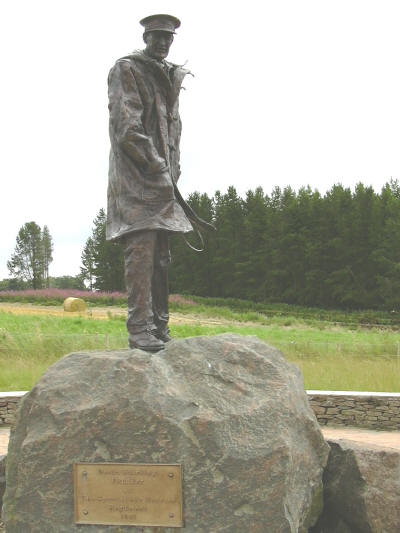
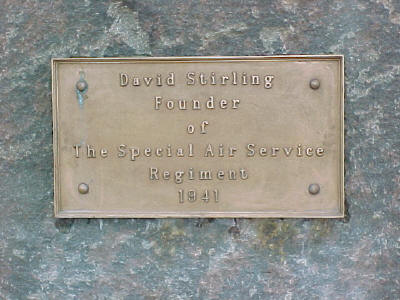
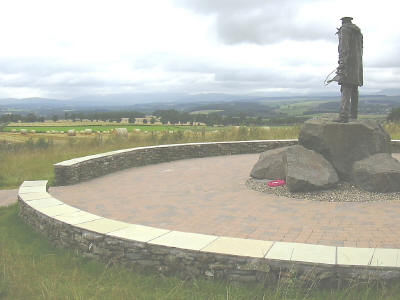
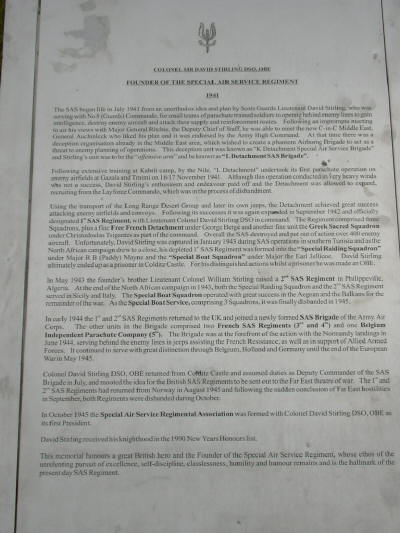
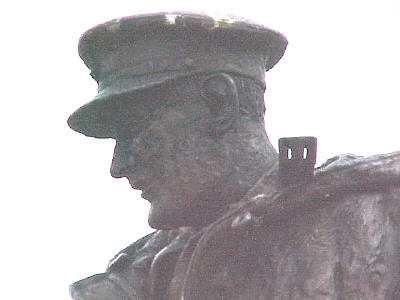
And a few more we took when we were there...
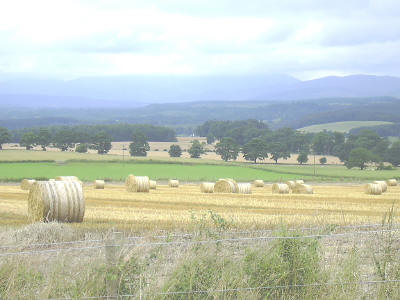
Scene from the Statue
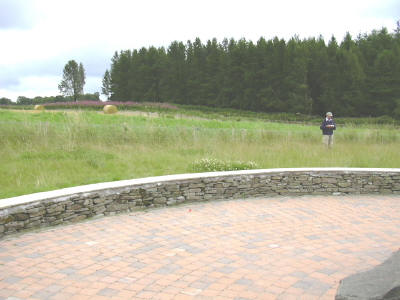
Ranald preparing to take a photo of the statue
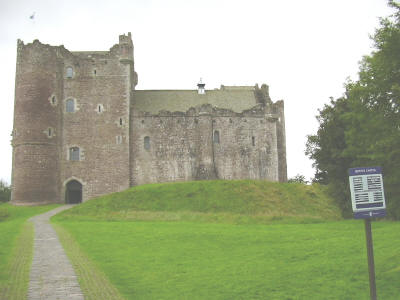
Doune Castle just 2 minutes drive from the
statue
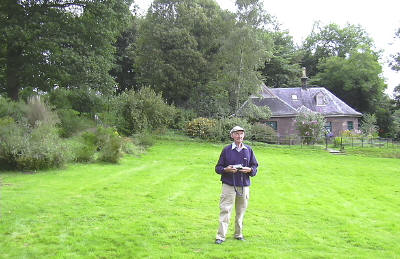
Ranald in front of his new cottage at Doune
Castle :-) |
